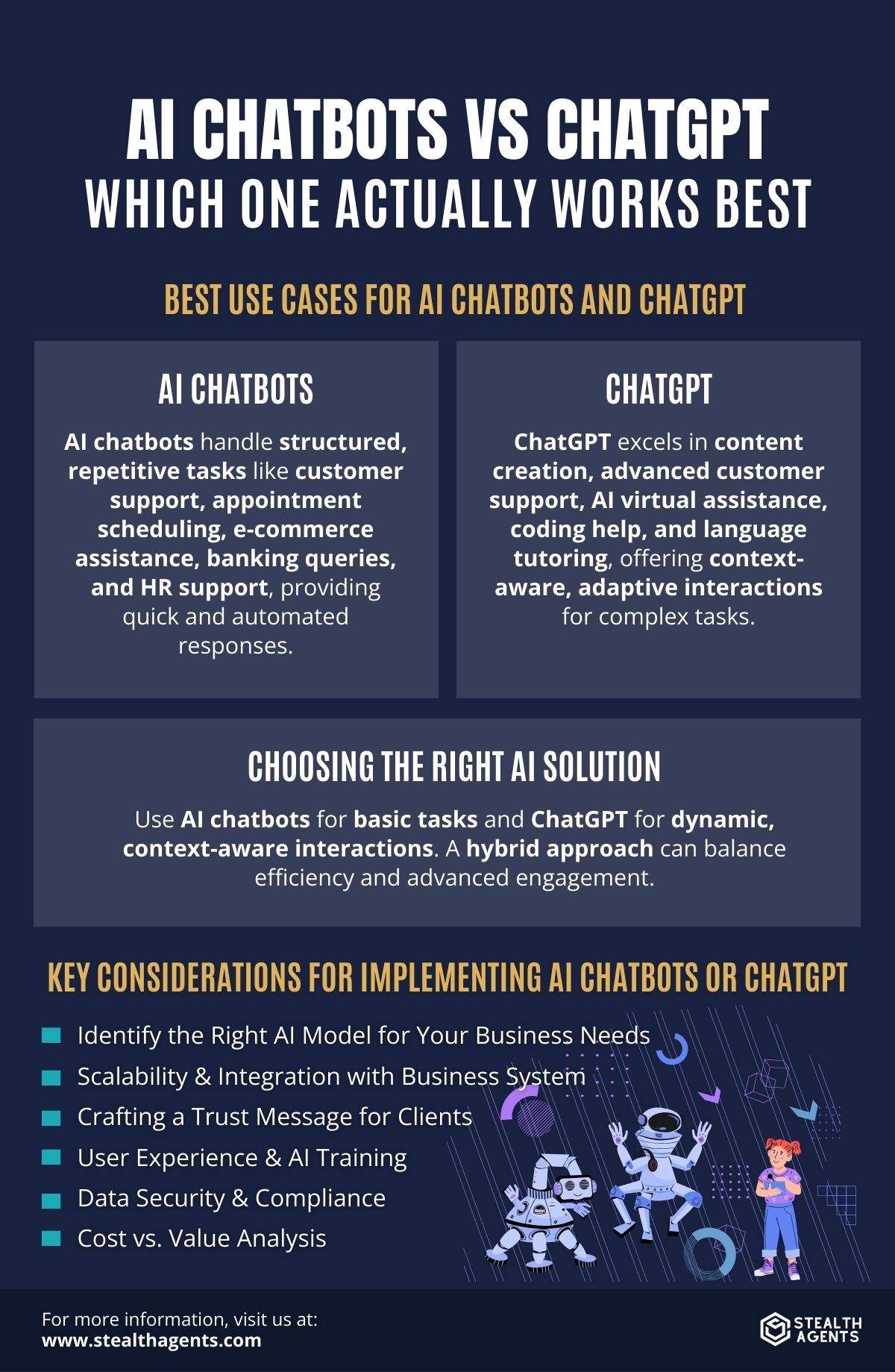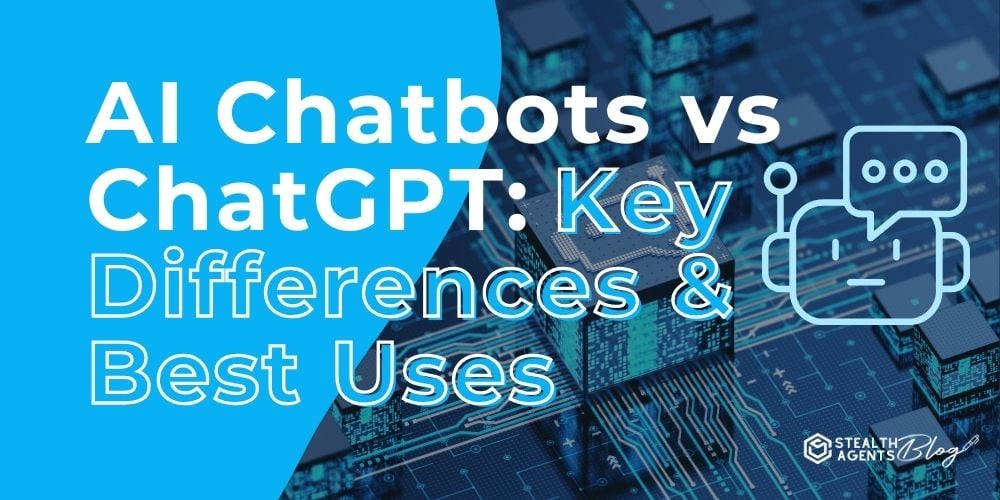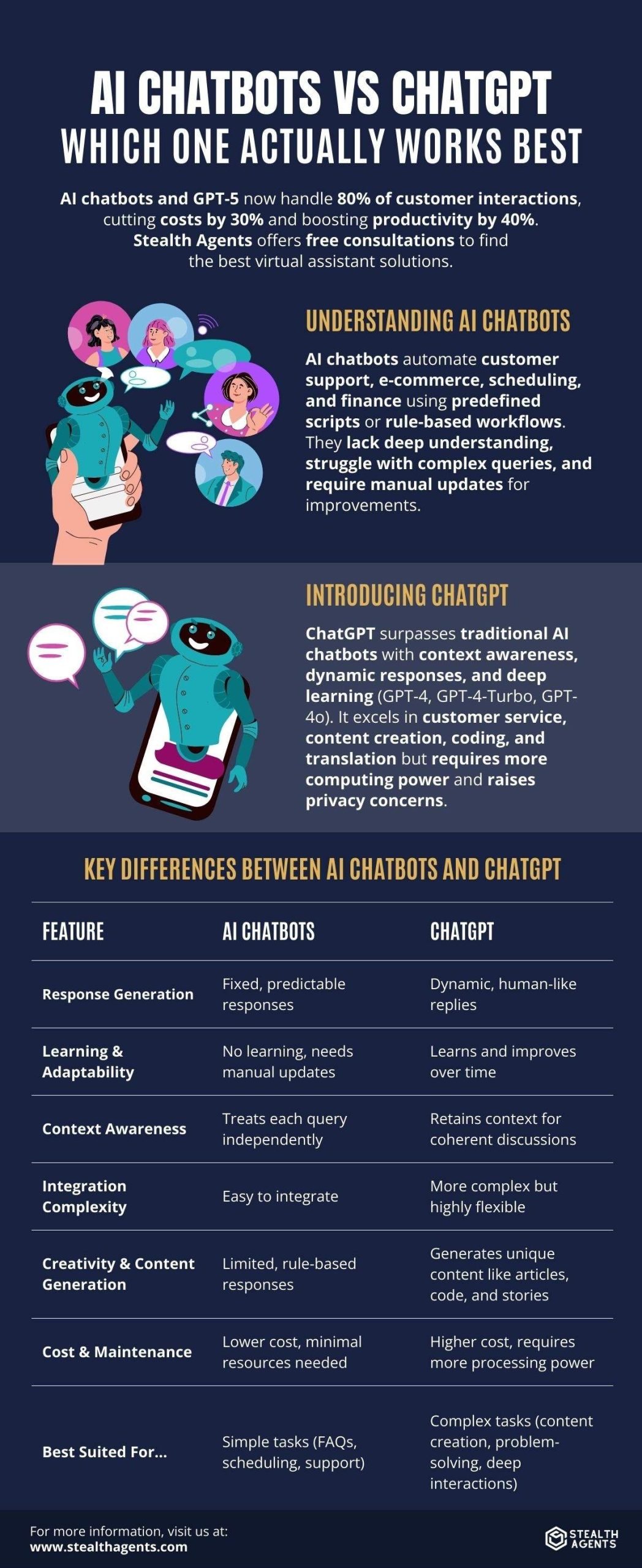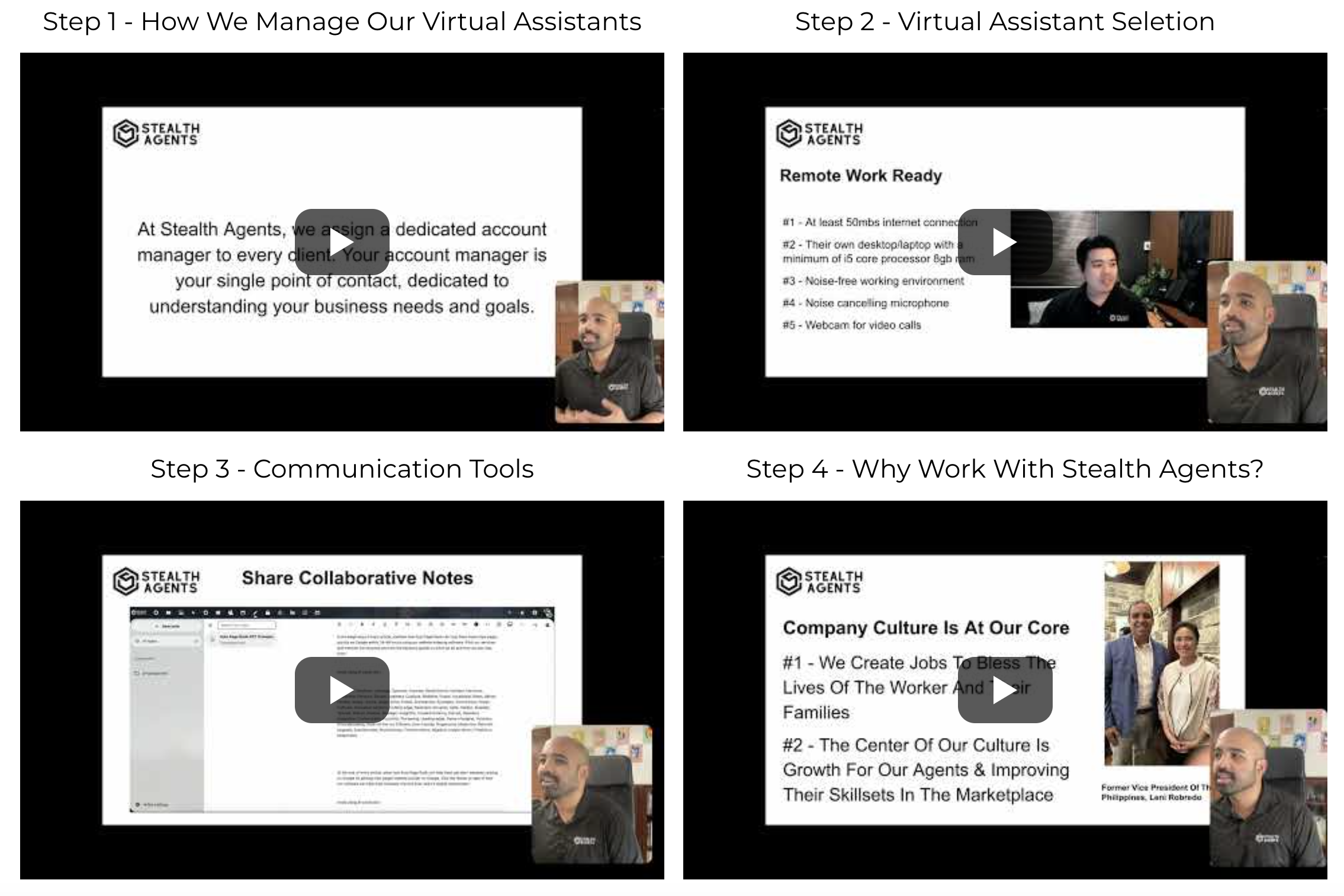Tools for virtual assistanttasks have evolved rapidly, with AI chatbots and GPT-5 shaping the way businesses operate. Did you know that 80% of customer interactions are now managed by AI, saving companies up to 30% in operational costs?
Both AI chatbots and GPT-5 deliver value, but their key differences lie in functionality and adaptability. While small businesses streamline customer support, BPO companies utilize AI-driven solutions for advanced problem-solving.
Recent studies show that businesses using virtual assistant technology see productivity improvements by 40%. To explore how these tools can benefit your business, Stealth Agents offers free consultations, helping you discover the best-fit solutions and competitive virtual assistant pricing.
1. Understanding AI Chatbots
AI chatbots are automated software programs designed to simulate human-like conversations, typically used in customer support, business automation, and user engagement. These chatbots follow predefined scripts or rule-based algorithms to respond to user queries. While some utilize basic machine learning, most rely on structured data and keyword recognition rather than deep understanding.
-
How AI Chatbots Work
- They follow decision trees or predefined workflows, meaning responses are limited to preprogrammed answers.
- Some use Natural Language Processing (NLP) but are often constrained by fixed datasets.
- They typically require manual updates to improve their responses.
-
Common Use Cases for AI Chatbots
- Customer Support: Answering FAQs, processing basic requests, and handling common troubleshooting.
- E-commerce Assistance: Providing product recommendations and tracking orders.
- Appointment Scheduling: Managing reservations and bookings.
- Banking & Finance: Checking balances, transaction history, and fraud alerts.
-
Limitations of AI Chatbots
- Struggle with complex or unexpected queries outside their programmed responses.
- Cannot generate original or creative content, as they rely on preset responses.
- Lack context awareness, making conversations feel robotic or repetitive.
2. Introducing ChatGPT
Unlike traditional AI chatbots, ChatGPT is a more advanced conversational AI model designed to understand, generate, and adapt to natural human language. Developed by OpenAI, it is powered by deep learning models like GPT-4, GPT-4-Turbo, and GPT-4o, making it significantly more capable than rule-based chatbots.
-
How ChatGPT Works
- It uses large-scale neural networks trained on vast datasets to generate human-like responses.
- Instead of following predefined scripts, it processes input dynamically, understanding context, intent, and tone.
- It can predict and generate text based on conversation history, allowing for fluid and engaging dialogues.
-
Key Capabilities of ChatGPT
- Context Awareness: Remembers previous messages within a conversation to provide relevant responses.
- Creative and Adaptive Responses: Generates unique answers rather than relying on fixed templates.
- Multi-Industry Applications: Used in education, healthcare, finance, marketing, and software development for various AI-driven solutions.
-
Common Use Cases for ChatGPT
- Customer Service Enhancement: AI-driven chatbots that can handle complex support queries and offer personalized recommendations.
- Content Generation: Writing blog posts, marketing copy, email drafts, and creative content.
- Coding Assistance: Generating and debugging code, explaining programming concepts, and optimizing scripts.
- Language Translation & Learning: Assisting with language translation, grammar corrections, and tutoring.
-
Limitations of ChatGPT
- May generate incorrect or misleading responses if the dataset lacks specific information.
- Requires more computational power, making it costlier than traditional AI chatbots.
- Privacy concerns, as it processes user data, requiring businesses to implement security measures.
3. Key Differences Between AI Chatbots and ChatGPT
Below is a comparison table highlighting the major differences between traditional AI chatbots and ChatGPT to help determine the best fit for your needs.
| Feature | AI Chatbots | ChatGPT |
|---|---|---|
| Response Generation | Uses predefined scripts and fixed responses, making replies predictable. | Generates dynamic, human-like responses based on deep learning and context. |
| Learning & Adaptability | Requires manual updates and cannot learn from new interactions. | Uses machine learning to understand diverse topics and improve over time. |
| Context Awareness | Treats each query independently, lacking memory of past interactions. | Retains context within a conversation, allowing for coherent, logical discussions. |
| Integration Complexity | Easier to integrate into websites, customer service platforms, and basic automation tools. | Requires more advanced integration, but offers greater flexibility in various applications. |
| Creativity & Content Generation | Limited to structured, rule-based responses; cannot create unique content. | Can generate articles, marketing copy, code, stories, and personalized content. |
| Cost & Maintenance | Lower cost, requires minimal computing power and updates. | Higher cost, as it requires more processing power and frequent improvements. |
| Best Suited For… | Simple, structured tasks like FAQs, appointment scheduling, and automated customer support. | Complex, dynamic conversations like content creation, problem-solving, brainstorming, and deep customer interactions. |
If you need a cost-effective chatbot for structured, repetitive queries, an AI chatbot is a practical choice. However, if you require a conversational AI that adapts, understands context, and generates creative responses, ChatGPT is the superior option.
4. Best Use Cases for AI Chatbots and ChatGPT
Both AI chatbots and ChatGPT serve different purposes depending on the level of complexity and adaptability required. Below are the best scenarios where each option excels.
Best Use Cases for AI Chatbots
AI chatbots are ideal for handling structured, repetitive tasks where predefined responses are sufficient. They are commonly used in:
- Customer Support Automation – Answering frequently asked questions (FAQs), providing basic troubleshooting, and guiding users through simple processes.
- Appointment Scheduling – Managing reservations and setting up reminders for businesses in healthcare, hospitality, and service industries.
- E-commerce Assistance – Helping users track orders, check return policies, and browse product recommendations.
- Banking & Finance Queries – Providing users with balance updates, transaction histories, and fraud alerts through secure, automated chat interfaces.
- HR & Employee Support – Assisting employees with leave requests, payroll inquiries, and company policies.
Best Use Cases for ChatGPT
ChatGPT is designed for complex, human-like interactions that require contextual understanding and adaptability. It works best in:
- Content Generation – Writing blog posts, marketing copy, creative content, and email drafts for businesses and individuals.
- Advanced Customer Support – Handling detailed, context-based queries, offering personalized responses, and assisting with product recommendations.
- AI-Powered Virtual Assistants – Serving as a smart assistant that can summarize emails, schedule meetings, and perform research.
- Programming & Code Assistance – Generating, debugging, and optimizing code while explaining complex programming concepts.
- Language Learning & Tutoring – Helping users with language translation, grammar corrections, and subject-specific tutoring.
Choosing the Right AI Solution
- If you need a low-maintenance chatbot for handling basic customer interactions, AI chatbots are the best choice.
- If you require deep, dynamic, and context-aware conversations, ChatGPT provides more advanced and personalized interactions.
- Some businesses may benefit from hybrid solutions, combining an AI chatbot for basic tasks and ChatGPT for complex conversations and content generation.
5. Key Considerations for Implementing AI Chatbots or ChatGPT
Before integrating an AI chatbot or ChatGPT into your business, it’s essential to evaluate several factors to ensure efficiency, cost-effectiveness, and user satisfaction. Below are key considerations for businesses, especially those in B2B industries and for international entrepreneurs looking to scale their AI capabilities.
1. Identify the Right AI Model for Your Business Needs
- If your business requires handling structured, repetitive queries, an AI chatbot is the best fit.
- If you need a chatbot that can engage in complex conversations, generate content, or assist with decision-making, ChatGPT is the better choice.
- Many businesses in B2B industries adopt a hybrid approach, using AI chatbots for basic automation while leveraging ChatGPT for deeper customer interactions.
2. Data Security & Compliance
- AI systems handle sensitive customer data, making data privacy and security a top priority.
- Businesses serving international entrepreneurs must ensure compliance with GDPR, CCPA, and other data protection regulations.
- Establish clear AI policies regarding how user data is stored, processed, and secured.
3. Crafting a Trust Message for Clients
- Transparency is key when integrating AI chat solutions. Users should understand when they are interacting with AI versus a human.
- Display a trust message for clients that reassures them about data security, AI limitations, and human intervention options when needed.
- Example: “This AI-powered assistant is here to help! Your privacy is protected, and you can always connect with a human if needed.”
4. Cost vs. Value Analysis
- AI chatbots are cost-effective for handling basic inquiries and automating customer service.
- ChatGPT requires higher computational resources, making it more expensive but also more powerful for content creation, customer support, and automation.
- B2B industries should evaluate the ROI (Return on Investment) of AI tools based on customer engagement, time savings, and improved efficiency.
5. User Experience & AI Training
- For AI to provide valuable interactions, it must be trained on relevant business data.
- International entrepreneurs must ensure AI solutions support multiple languages and cultural variations to improve customer engagement globally.
- Regularly update and optimize chatbot responses based on customer feedback and new business trends.
6. Scalability & Integration with Business Systems
- AI solutions should integrate seamlessly with CRM, email, sales, and workflow management tools to ensure smooth operations.
- Businesses expanding globally must ensure scalability, allowing AI to handle increased user demand without compromising response quality.
- ChatGPT can be fine-tuned for industry-specific applications, making it a valuable tool for B2B industries looking for AI-driven automation.

Takeaways
AI chatbots and ChatGPT each serve distinct purposes, and the right choice depends on a business’s specific needs. AI chatbots are best for handling structured, repetitive tasks, making them ideal for B2B industries that require fast and efficient customer interactions.
On the other hand, ChatGPT provides more dynamic, context-aware responses, making it a powerful tool for international entrepreneurs looking to enhance engagement and automate content creation. Regardless of the AI model used, businesses must prioritize data security, seamless integration, and a clear trust message for clients to ensure transparency and reliability.
By carefully considering these factors, companies can successfully implement AI-driven solutions to improve customer experiences, streamline operations, and stay competitive in an increasingly digital world.













